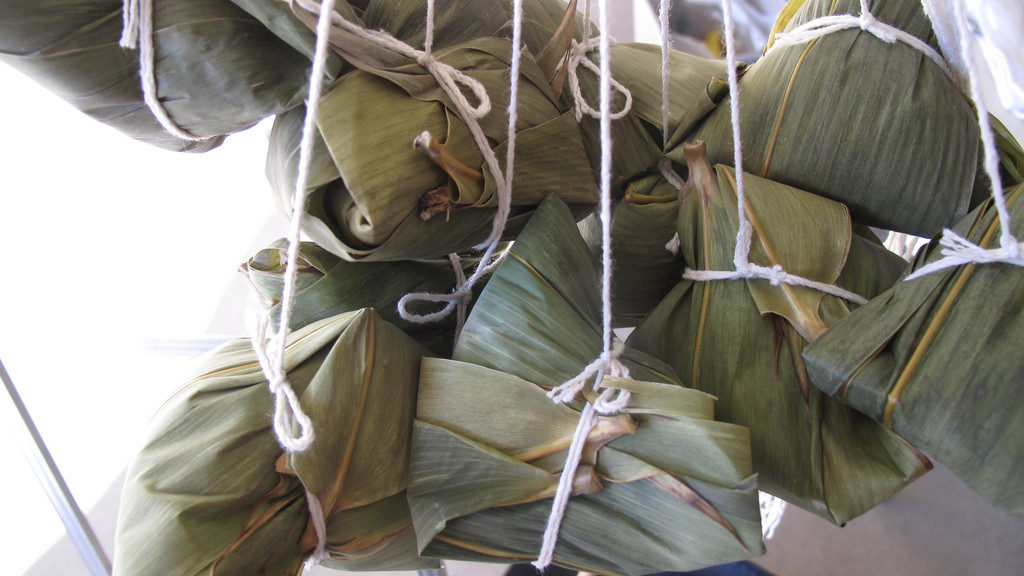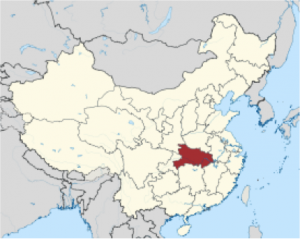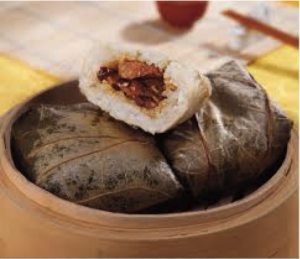Zongzi (or simply zong) (Chinese: 粽子) is a traditional Chinese food, made of glutinous rice stuffed with different fillings and wrapped in bamboo, reed, or other large flat leaves. They are cooked by steaming or boiling. In the Western world, they are also known as rice dumplings or sticky rice dumplings.
Zongzi (sticky rice dumplings) are traditionally eaten during the Duanwu Festival (Mandarin: Duānwǔ; Cantonese: Tuen Ng), which falls on the fifth day of the fifth month of the lunar calendar (approximately late-May to mid-June).
The fillings used for zongzi vary from region to region, but the rice used is almost always glutinous rice (also called “sticky rice” or “sweet rice”). Depending on the region, the rice may be lightly precooked by stir-frying or soaked in water before using. In the north, fillings are mostly red bean paste and tapioca or taro. Northern style zongzi tend to be sweet and dessert-like. Southern-style zongzi, however, tend to be more savory. Fillings of Southern-style zongzi include salted duck egg, pork belly, taro, shredded pork or chicken, Chinese sausage, pork fat, and shiitake mushrooms.
Zongzi need to be steamed or boiled for several hours depending on how the rice is made prior to being added, along with the fillings. However, as the modes of zongzi styles have traveled and become mixed, today one can find all kinds of zongzi at traditional markets, and their types are not confined to which side of the Yellow River they originated from.
History of Zongzi
Zongzi are traditionally eaten during the Dragon Boat Festival (端午節), on May 5th of the lunar calendar. It is said that on this day, Qu Yuan, a famous Chinese poet who lived in the Chu kingdom, drowned himself in the Miluo River. Before this, he tried to warn his king and his people that their neighbor, the Qin kingdom, was going to invade the Chu kingdom. When the Chu capital was taken over, Qu Yuan was so upset that he drowned himself. When his body could not be found, people threw packets of rice into the river to prevent the fish from eating it.
Regional origin: The Chu kingdom was in present day Hubei
Possible Variations:
Jianshui Zong (碱水粽) – usually eaten as a dessert; the glutinous rice is treated with lye water to make it more alkaline. The rice turns yellow and sweet. It usually has no filling or is filled with sweet mixtures, such as a red bean paste.
People in the north tend to make sweet zongzi. Their fillings could have dried dates, chicken, or red bean paste. People in the south tend to make savory zongzi with pork, Chinese sausage, and mung beans.
Nyonyazong (娘惹粽) – a part of the cuisine unique to Chinese Malaysians/Singaporeans; similar to southern Chinese zongzi, but the filling is made with minced pork with winter melon, ground roasted peanuts, and a spice mix
Taiwanese Zongzi – 臺灣粽; similar to Chinese zongzi, but wrapped with different leaves; not as fatty; pork, mushroom, salted duck egg, peanuts, chestnuts as fillings (some put dried squid or shrimp as well); some are vegetarian so the filling would have only peanuts.
Related Cuisine
糯米雞 (nuomji) is a Cantonese dim sum dish; steamed sticky rice with chicken in lotus leaf wrap. Fillings include chicken, Chinese sausage, salted egg, dried shrimp, mushrooms, and scallions. It’s usually wrapped in a square instead of a prism.


